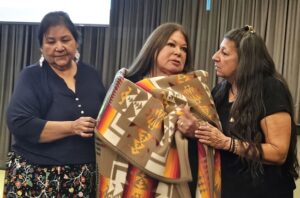Aamjiwnaang member becomes CEO of health access centre

By Sam Laskaris
AAMJIWNAANG FIRST NATION – She’s back.
After a year of working elsewhere, Janice Martin once again finds herself employed by the Southwest Ontario Aboriginal Health Access Centre (SOAHAC).
Martin, a citizen of Aamjiwnaang First Nation, has been appointed as the CEO of SOAHAC, which has six locations in the province. Martin had previously spent five years working as an integrated care manager at SOAHAC’s Chippewas of the Thames First Nation site, and spent three years as SOAHAC’s director of Indigenous relations.
Martin had her swearing-in ceremony and officially took over as the centre’s CEO on Nov. 22.
Besides the Chippewas of the Thames site, SOAHAC also has locations in Windsor, London, Owen Sound, Cambridge, and in the village of Newbury.
SOAHAC uses Western health practices to guide its care delivery, but the centre grounds its work with Indigenous teachings, cultures, and approaches.
Now that she’s SOAHAC’s CEO, Martin is planning to implement some changes.
“It could be done stronger,” she said of the centre’s current care delivery. “I think what we have to do at all of our sites is see what healing we have and what is needed to improve it.”
SOAHAC is part of a group of Aboriginal Health Access Centres that were introduced in the province in 1995. There are currently ten AHACs in Ontario, providing services both on and off-reserve, in urban, rural and northern locations. The centres were launched in response to the epidemic, systemic health disparities, and inequities within the Indigenous population in Ontario.
Health and social services the health centres provide include the following:
- traditional healing
- primary health care
- health promotion services
- cultural programs
- community development initiatives
- social support services.
Martin said SOAHAC currently has 161 employees. A total of 53 per cent of these workers identify as Indigenous.
“I’m happy for all of our providers who provide service to our people,” Martin said. “Help is very complex. It’s difficult to work at these sites.”
Martin would welcome even more Indigenous staff members.
“We’d love to see our people working here,” she said. “We’re always looking for Anishinabek doctors and nurse practitioners.”
Martin said she has already met SOAHAC’s board of directors and integrated care manager at all of the sites.
Board members meet monthly. Prior to the board’s December meeting Martin was hoping to get her hands on SOAHAC’s strategic plan, which was released earlier this yea, to familiarize herself with the centre’s future plans before her first official board meeting.
Martin is keen to also set up meetings with all of SOAHAC staff members, either in group settings or one-on-ones.
Besides looking to recruit capable employees when funding is available for new hires, Martin also is eager to retain current workers.
“We want the staff to feel there is stability here with a new person in charge,” she said.
SOAHAC’s services are funded by various groups. They include the Ministry of Health, the Ministry of Health’s mental health and addictions division, the Ministry of Children’s community and social services, Ontario Health West, and the City of London


